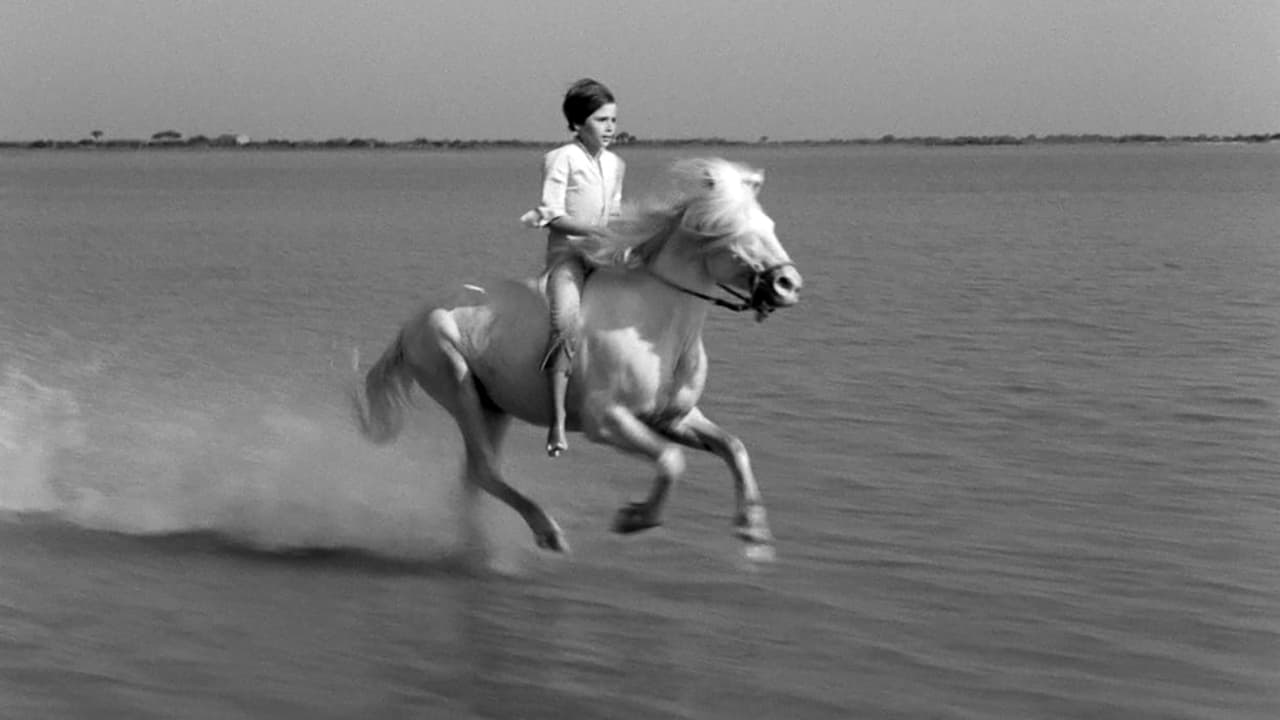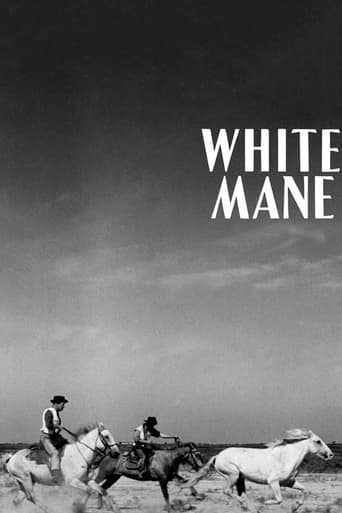

"White Mane" was directed by the French filmmaker Albert Lamorisse, who also made the better-known "The Red Balloon" from three years later. The two films have several things in common, apart from the fact that both feature the name of a colour in their title. Both are very short ("White Mane", the longer of the two, only runs to forty-seven minutes) and have little in the way of dialogue. Both are centred upon the adventures of a young boy who finds an unusual playmate (a horse here, a seemingly- sentient balloon in the later film). Both are told in the form of a fable rather than of a realistic story, and have an enigmatic ending which can be interpreted symbolically.There are, however, also a number of differences. "The Red Balloon" was set in Belleville, a working-class district of Paris. It was filmed in colour, but the colours, apart from the red of the balloon itself, are dull and muted, in keeping with the gritty urban setting. "White Mane", by contrast, was shot in black-and-white on location in a remote rural area, the marshes of the Camargue in the South of France.The Camargue is noted for its herds of free-roaming wild horses, and the film tells the story of one of them, a white stallion called White Mane (Crin Blanc in French). A group of ranchers persistently try to capture him but White Mane, who distrusts men, always manages to escape. The only human who can tame him is a boy named Folco who lives in the marshes with his fisherman grandfather and younger brother.The story is a simple one and the film has always been popular with children. As with "The Red Balloon", however, there is plenty of symbolism for adult audiences who like that sort of thing. The wild horse becomes a symbol of freedom; he resists the ranchers, who try to capture him by force, but he will submit to Folco who captures him through love. There may also be a specifically religious meaning behind the films, which starts with the colour-references in the titles; in Christianity red is the colour of martyrdom and white that of purity. Religious symbolism can be attributed to the endings of both films; here White Mane takes Folco through the sea (the waters of baptism?) to an island where "horses and men can always be friends", a possible reference to an afterlife.Such attempts to attribute symbolic meanings to films, especially children's films, will always be controversial and there will always be ample grounds for disagreement about such matters. One area, however, which I suspect will give rise to little controversy is the film's visual impact. Lamorisse's clean, vibrant black-and-white photography is absolutely masterly, revealing the wild, lonely beauty of the marshes. It is the sort of film which one could, if one were in the mood, watch simply as a succession of striking images, without giving much thought either to the story or to its underlying meaning. In this respect I felt that "White Mane" excelled even the high standard of "The Red Balloon". 9/10
... View MoreAlbert Lamorisse is mostly known for his beloved classic 'The Red Balloon', but before that he made this 'White Mane', which is almost as good. Although 'White Mane' is not absolutely perfect, it certainly is and feels authentic. I could say this is a must for anyone who loves horses. It is, that I can't deny. But in my book one doesn't necessarily have to love horses to enjoy this. It's all a matter of liking this sort of films.This short film is about a wild stallion in a wild region of France and his friendship with a fearless and adventurous young boy. The film tells how they meet and how they develop their friendship. This boy becomes the only human really worthy of the stallion's trust.The beauty of the cinematography is one of the best things about this. What we see is pure and natural, a "wilder" France not often seen in movies (that is, as far as I know). The boy is wonderfully portrayed by Alain Emery. The boy and the stallion have a perfect chemistry.This should definitely be on Top 250.
... View MoreIn the mid-fifties, Albert Lamorisse produced two beautiful, but strangely distant films, "The RedBalloon" and "White Mane". "Red Balloon" has been available and remained somewhat popular, while "White Mane" all but disappeared. Its re-emergence is welcome, as it offers intensely compelling black and white imagery, cinematography that is a cross between Ansel Adams and Atget, in its rich tones, dramatic light, and epic feel.Red Balloon, offers an interesting contrast. Paris is all muted earth tones and grays, with the balloons offering the only vivid colors. It is also interesting to remember that World War II was less than a decade earlier.Little Pascal, the director's son, is seen in both films, always appealing never "cute", but somehow distant. We don't really know him except as "the little boy".The two films are wonderful artifacts from a time when film was more art than marketing.
... View MoreEvery French pupil of the sixties or even the seventies knows "Crin-Blanc",one of the major works of Albert Lamorisse who used to make films aimed at the children's market: "Bim Le Petit Ane" "Le Voyage en Ballon" and "le Ballon Rouge" are of the same kind.The French critic remains tepid as far as they are concerned,but abroad all are praised as masterpieces of moving poetry.Let's take the golden middle:masterpieces,there are certainly not,but representative of an era ,the era of Doisneau's photographs and pupils in grey overall,they certainly are.Whereas "le Ballon Rouge " depicted a graying urban landscape,"Crin-Blanc" takes place in Camargue with its wild horses ,including ,the wildest of them all,"Crin-Blanc ".But the two movies have the same conclusion: both Folco and Pascal cannot live in the men's world and both escape from their world,one flew over Paris with his magic balloon and the other returned to the (new christening?) waters of the river with his mythical horse.
... View More